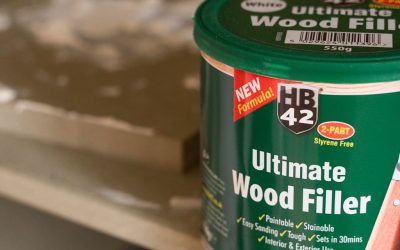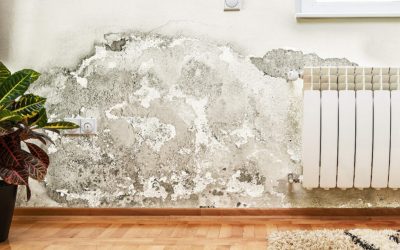There’s nothing worse than existing in a room afflicted with damp, mould and mildew. It looks ugly, it’s unhealthy for our bodies, and it makes it practically impossible to relax with the issue at the back of our minds.
Fortunately, though, mouldy walls can be dealt with efficiently: with the right care and attention, they can bounce back, looking good as new. Which is exactly what this guide is here to prove. We’ve got our trade professionals at HB42 to share their insights and top tips on how to remove mould from walls swiftly and effectively, so you can do the best job – no unnecessary touch-ups needed.
Skip to:
- Why are Mouldy Walls a Common UK Problem?
- What Causes Mould to Grow on Interior Walls?
- How to Remove Mould from Walls Safely
- Dealing with Stains and Repainting After Mould Removal
- Quick Tips to Stop Mould Coming Back
- When Should You Call a Professional?
- Final Thoughts
Why Are Mould-Infected Walls Such a Problem in UK Homes?
We all know it: mould is a major problem in the UK. We’ve heard all the anecdotes and likely lived through it, and that’s not surprising if you take a look at the official data. Yes, in England alone, there are around 2 million people currently living in homes significantly impacted by damp and/or mould. That’s 3-4% of residents!
The reasons for this problem are manifold. For one, a large portion of British homes are small, poorly ventilated and lacking sufficient insulation. And while it’s easy to blame only older, poorly built or poorly maintained properties, the reality is these issues cut across all types of housing, however well-looked after they are. As a USwitch Energy study found, mould affects privately rented, owner-occupied, student and council homes alike.
Other big culprits for damp conditions are cold homes; predictably, the soaring costs of energy prices have had an impact, with 56% of the study’s respondents believing their reduced use of heating has contributed to worsening mould. This said, there are plenty of other hidden causes – but put a pin in that for now.
A growing issue for tenants and homeowners
The government has recently introduced Awaab’s Law – a new regulation designed to make homes safer and healthier by tackling damp and mould head-on. The law came about after the tragic death of two-year-old Awaab Ishak in 2020, caused by prolonged exposure to mould in his family’s social housing flat.
Under the new rules, which come into force in October 2025 for social housing in England, landlords are legally required to investigate and fix serious damp or mould problems quickly. Emergency issues must be looked at within 24 hours, while other significant cases have to be investigated within 10 working days and repaired within a further 5 days once identified. Landlords also have to provide tenants with written confirmation of what’s been found and what action is being taken.
At present, Awaab’s Law only applies to the social rented sector, but similar standards are expected to be rolled out to private rentals in the near future meaning that knowing how to remove mould from walls and prevent its return is absolutely essential. For tenants, this means clearer rights and faster responses when mould becomes a health hazard. For landlords, it’s a strong reminder that mould isn’t just a cosmetic problem – it’s a serious safety issue that demands prompt attention.
What Happens if you Ignore Mould?
Ignoring mould is never a good idea. Extended and close quarters exposure can lead to a whole host of health problems like asthma, allergic reactions, respiratory infections and headaches, particularly for those belonging to vulnerable groups, including children, the elderly or immunocompromised.
On top of the health impacts, it’s important to note the potential impact of property damage, which can take the form of rotting and damaged drywall, wallpaper, and wooden fixtures, to name a few. Some of these examples are irreversible and expensive to fix, so it’s never worth risking a spreading infestation. Act wisely by acting fast.
What Causes Mould to Grow on Interior Walls?
Ready to take that pin out? Here are all of the main reasons why the fuzzy stuff is sprouting in your home, all of which will help guide your understanding of how to remove mould from your walls and keep it from coming back.
- Condensation and Poor Ventilation: When warm, humid air collides with cold surfaces, it turns into water droplets – AKA condensation – which, left unventilated, can create a moist environment that provides the perfect microbiome for mould spores to grow.
- Structural Problems: Issues like cracked damp proof courses, damaged gutters, or a cellar that needs tanking can each let water seep into walls.
- Gaps and Cracks: Fissures in your walls and adjacent surfaces create perfect nooks for spores to take hold because they’re difficult to reach, and moisture accumulates. Make sure they’re properly plugged up with a high-quality sealant.
- Leaks, Rising Damp, and Water Damage: Yep, mould thrives in cool, damp conditions, so check for issues featuring excessive moisture exposure.
- Daily Household Habits: There are reams of household habits that can contribute to a buildup of mould in your home, which include but are not limited to…
- Drying wet clothes indoors
- Rarely opening the windows
- Leaving the bathroom door open while showering, or the kitchen’s when cooking
- Forgetting to cover pans when heating food
- Leaving spillages and never cleaning your carpets
- Blocking airways and hindering ventilation with furniture and other clutter

How to Safely Remove Mould from Walls in 5 Easy Steps
How do you remove mould from walls? Fortunately, the process is very simple and practically anyone can do it, provided the affected area is a modest size and you’re in a fit and healthy condition.
Safety first: What you need to know
Before we dive right into how to remove mould from a wall, allow us to run through an important disclaimer. If you fall into one of the vulnerable categories we spoke about earlier, for instance, your respiratory system is weak or you’re immunocompromised in any way, it’s best to leave the work to someone else, be they a professional, family member or a friend.
For those who don’t belong to these categories, it’s still crucial to mask up and wear gloves to protect yourself from the spores, so getting your hands on some PPE is a must.
Feeling up to it? Then read up on the tools you’ll need:
Tools & Cleaning Solutions
- Scruffy clothes you don’t mind chucking in the wash right after
- Rubber gloves, eye protection and a facemask
- Bucket or spray bottle
- Cloth or rags
- Tea towels
- Hoover
- Your cleaning solution of choice
Step 1: Prep the Area & Avoid Spreading Mould Spores
Before you go about removing the mould, make sure to prep the area appropriately. By opening the windows, you increase ventilation, which will be needed when you start spraying, and moving furniture and other items out of the way will prevent them from being damaged. Finally, ensure that the door is properly closed to confine the mould spores to the area, as they’ll become dislodged once you start wiping.
Step 2: Apply Your Mould-Removal Solution
With your room set up and your protective gear on, you can begin applying the mould-removal solution with a cloth, rag or spray bottle. Here you can use one of many options:
- Method 1: Warm soapy water for smaller areas
- Method 2: White vinegar for more chemically sensitive areas, such as a child’s bedroom
- Method 3: Bleach solution ( 1 part bleach, 4 parts water) for tougher areas
- Method 4: A dedicated commercial mould remover for a quick, fuss-free job
Step 3: Let It Sit
Once you have sprayed or wiped on the solution, allow it to sit for 30 minutes to an hour, so it can work its magic. It may vary between commercial cleaners, so do always check the manufacturer’s instructions.
Step 4: Dry the Area
When your timer goes off, you can wipe it clean with your cloth, rag, or even a sponge. Be thorough and don’t miss any residue. Also, be careful not to drip the mucky water on the floor, especially carpets – have a bucket on standby to deposit your dirty supplies.
Step 5: Evaluate the Job & Consider Follow-Up Work
There you go – your walls should be visibly mould-free! Now, it’s time to think about follow-up steps. For instance, you might be left with some ugly stains and discolouration, leaving you with some repainting in the works.
Another thing to note is that, since plasterboard walls are porous and therefore susceptible to deep mould penetration, you will need to think about replacing sections of the plasterboard that have been affected. While cleaning the visible layer of fungus might rid the surface of mould, there could still be spores hiding deeper inside.
Dealing with Stains and Repainting After Mould Removal
… Speaking of follow-up, here’s what to do with your walls now that they’re clean.
Removing mould stains
Sometimes, even after cleaning, you’re left with stains from the mould or where an unwashable paint has come off. Not to worry, though! You can patch up those unsightly blotches.
For light staining, give the area a scrub with your solution again and see how that fares. Still not working? For considerably more stubborn marks, use a stain-blocking paint primer to cover them up.
When and how to repaint
Your timeline is as follows: wait until the wall is completely dry, typically 1-2 days depending on room humidity, and once you’re certain the surface is moisture-free, you can get started.
Begin with some surface prep. You’ll need to do some light sanding if the existing paint layer has bubbled to ensure a smooth finish. Make sure to remove any dust and debris with a damp cloth.
With those steps out of the way, you can apply your paint as per the instructions of the product, aiming for even, smooth coverage and at least two layers to hide the stain. With two-in-one, self-priming paints, you can apply the product right away – eliminating the need for a separate primer.
Using mould-resistant coatings
Once the mould on your walls is cleaned and the causes are addressed, your best shot for a long-term fix is to repaint the area with a high-grade mould-resistant paint like HB42’s PS2 Primer Sealer Stain Blocker.
The benefits here are many: it creates a barrier to moisture, inhibits future mould growth and saves future time and money on repairs – all whilst keeping your walls looking spic and span.
The HB42 coatings range is a great place to start, as they provide robust, long-lasting protection, especially in susceptible areas like kitchens, bathrooms and behind furniture. To decide which of the bunch is to your liking, watch our comparison guide below.
Seal Up Vulnerable Spots
Another helpful tactic is to seal up any vulnerable spots in your walls or in adjacent areas where small cracks, gaps or poorly sealed joints can let moisture sneak back in.
If you notice peeling caulk around your bath or shower, that’s a red flag. Water can easily escape behind the tiles or fittings, soaking into nearby walls and creating a breeding ground for mould.
- To prevent this, reseal any compromised joints around your bath, kitchen counters, sinks or shower. Use a high-performance sealant that’s anti-fungal, flexible, and long-lasting.
- We recommend reading our guide on how to seal and reseal a bathtub and checking out our top choice for the best bathroom sealant for showers and baths.
- Don’t forget to also seal around window frames, pipework and external vents, or wherever else moisture can enter.
Quick Tips to Stop Mould Coming Back
We’ve covered everything you could possibly need to know on how to remove mould from walls, but what about stopping it from coming back? Here are some tips to help keep the spores at bay. As they say, prevention is better than cure.
Daily Ventilation Habits
- Open windows daily, even for just 10–15 minutes, especially after showers or cooking.
- Keep furniture and other items slightly away from external walls to allow airflow.
- Always use extractor fans in kitchens and bathrooms (and leave them running for 10 mins after use).
Tech that Helps (Dehumidifiers, Extractors)
- Use a dehumidifier in particularly damp rooms, when you’re drying clothes inside or during colder months; the ideal humidity is between 40–60%.
- Make sure your kitchen and bathroom extractor fans are working properly and powerful enough for the room size.
- Consider installing trickle vents in windows if condensation builds up regularly.
Watch for Leaks or Damp Returning
If you see wet patches, bubbling or peeling paint and other suspicious marks on your walls, get a professional in asap or contact your landlord; it’s likely that there’s an underlying problem with leaks or rising damp that needs to be addressed.
Spotting Signs of Deeper Issues
If you’ve followed all of our prior suggestions to remove the mould from your walls and safeguard against its return, and it’s still coming back, that might be your sign to get a tradie to look at it.
Mouldy walls might be an indication of structural faults, particularly if the mould is accompanied by signs of penetrating damp, i.e., water stains, damp patches higher on the wall, discoloured mortar, dodgy-looking brickwork or cracks in the external wall that match up to the inside. Other things to look out for are bubbling plaster, rotting woodwork or damage to other external elements in the vicinity, such as roof tiles or guttering. Uncertain where the moisture is coming from? Definitely get a second, qualified opinion.
When Should You Call a Professional?
In the arena of damp and mould, DIY cleans and repairs are usually pretty doable, but sometimes there are circumstances that call for the expertise of a professional. Red flags include when the affected area is larger than one square metre, you suspect hidden mould, or the source of the issue is a structural problem. Here, follow the all-important maxim: if it looks more serious than a DIY job, it probably is.
Final Thoughts: Don’t Just Cover It, Cure It
Now you know exactly how to remove mould from your walls, it’s time to put those learnings into practice. Deal with the affected areas quickly and efficiently so they don’t become a bigger nuisance. Keep doors closed when you’re applying your solution to prevent spores escaping, and don’t forget to reseal and treat those walls once the mould is gone.
Ready to safeguard your home? Explore HB42’s solutions for long-term protection – from all-purpose sealants to powerful stain-blocking coatings. With a bit of TLC, you’ll forget mould was a problem in the first place!









0 Comments